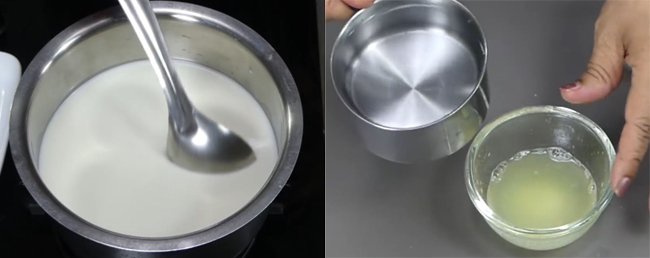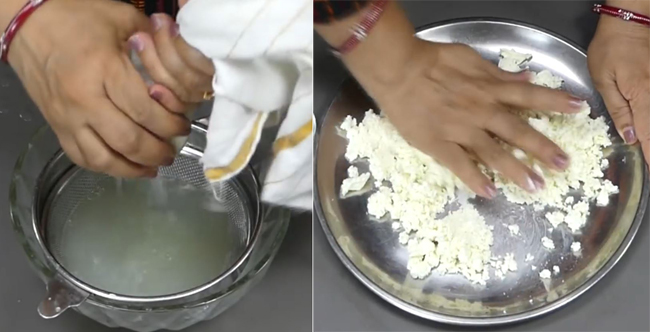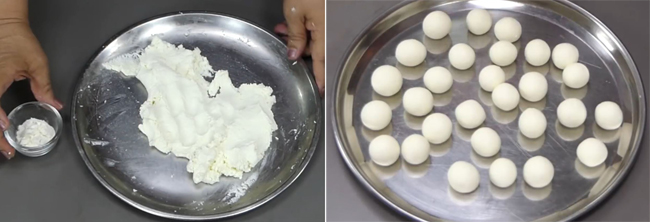5 Tips for soft spongy Rasgulla | How to make Spongy Chenna Rasgulla
- Nisha Madhulika |
- 37,384 times read
.jpg)
Among the variety of Indian sweets, Rasgullas holds a prime position. Spongy Rasgullas are like staple desserts for every Indian festival. They are delicious and enjoyed across the nation.
Today, we will discuss every problem encountered while preparing Rasgulla, then we will find their root cause and ways to solve those problems.
5 Tips for soft spongy Rasgulla
For perfectly spongy and soft Rasgulla, there are 5-base rules to follow, and together with these rules, we will answer questions like How to make soft Bengali rasgulla, Why does Rasgulla become hard, How can we stop Rasgulla from breaking, and many other?
Rule 1: Additive-free Cow or Buffalo Milk
Milk is the main ingredient required for preparing Rasgullas, so make sure it is free from additives. If cow milk is not available, you can use Buffalo milk.
Some people add baking soda to the milk to extend the milk's shelf life, which makes it hard to curdle the milk. First, the milk will not turn sour, and even if it does turn sour, the Chenna will not be soft.
So, ensure that the milk is additive-free for preparing soft Chenna. Let's move on to the next step.
Rule 2: Prepare a soft chenna
To prepare Chenna, bring the milk to a boil. Stir the milk occasionally to avoid clinging at the bottom of the cooking vessel. Turn off the flame once the milk comes to a boil.

Question: Why does Rasgulla become hard?
Reason 1: Adding lemon juice in the boiling milk will make the Chenna stiff. Hence, Rasgullas will become hard.
Suggestion: After turning off the flame, wait for 2-3 minutes before adding lemon juice. In short, allow the milk to cool down slightly.
Reason 2: Do not pour the whole lemon juice in the milk at once, as the Chenna will become hard and too sour.
Suggestion: Dilute the extracted lemon juice with an exact amount of water. Add 1-spoon of lemon juice to the milk and give it a light stir. Again add 1-spoon of lemon juice and stir the milk. Repeat the same process till the milk starts to curdle.
Reason 3: Do not keep the curdled milk aside for too long without straining; otherwise, our Chenna will turn out hard.
Suggestion: Stop adding lemon juice once the milk turns completely sour. Rest the curdled milk only for 2minutes and immediately strain the Chenna into a cloth.

Wash the Chenna 2-3 times with cold water to wash away the lemon sourness. Once done, wrap the Chenna in a cloth and squeeze it to discard excess water. This way, you will prepare a perfectly soft Chenna.
Rule 3: Roll smooth Rasgullas from soft Chenna
To prepare Rasgulla, we need to prepare the dough for it. Take the Chenna out on a plate, and with the help of your palm, knead it for 4-5 minutes. The Chenna will become as soft as Makhan.

Question: Does Rasgulla contain Maida?
Answer: Bengali style Rasgulla recipe only uses Chenna. Whereas, Delhi style Rasgulla, aka Seb Rasgulla, uses 1-2 spoons of other ingredients like maida, cornflour, arrowroot, or suji. After adding these ingredients, we knead the dough properly.
Questions: How can we stop Rasgulla from breaking?
Answer: Cracks form in Rasgulla only when the dough is not smooth enough. If your Rasgullas have cracks, then knead the dough for another 3-4 minutes to make it cracks-free.

Rule 4: Do not interrupt the boil in the Chashni. Ensure that the Chashni is not thick.
We need Chashni to cook the Rasgullas. To prepare Chashni, if you are taking 1 cup sugar, then you are supposed to add 2-3 cups of water in it.
We don't need one-thread consistency syrup; we want the sugar to dissolve in water. Add the Chenna balls in the syrup only when the syrup is boiling.

When dropping the Chenna balls in the syrup, ensure that the flame is high. Do not interrupt the boil in the syrup and drop one ball at a time; otherwise, the balls might burst while simmering.
We have to simmer the Rasgullas for 17-18 minutes in the syrup. Ensure that the Chashni does not get thick while in the process.
Question: Why does rasgulla shrink?
Answer: After 10-12 minutes of simmering, the Chashni starts getting thicker. Due to the thickening of the Chashni, the Rasgullas fail to puff up, but instead, they shrink.
Suggestion: After 10-12 minutes, check the syrup, and if the Chashni starts to thicken, then gradually pour boiled water in the Chashni. Ensure not to disturb the boil in the Chashni while adding the water because again, the Rasgullas might shrink.
Rule 5: Let the Rasgullas stay immersed in the syrup for 5-6 minutes after being cooked.
After simmering the Rasgullas for 17-18 minutes, turn off the heat and leave the Rasgullas immersed in the syrup for 6-8 minutes.
If you take out the rasgulla immediately, they will not be as sweet, and they may lose their shape.
So, keep these rules in mind and prepare soft and spongy Rasgulla. For more detailed information, please refer to the video uploaded below.
5 टिप्स स्पंजी छैना रसगुल्ला के लिये | 5 Tips for soft spongy Rasgulla | How to make Spongy Rasgulla
Tags
- 5 Tips for soft spongy Rasgulla
- 5 Tips for soft Rasgulla
- How to make Spongy Chenna Rasgulla
- Bengali Rasgulla
- Chhena Rasgulla
- Rasgulla Making Tips
- Why does Rasgulla become hard?
- Why rasgulla shrink ?
- why rasgulla breaks ?
Categories
- Sweet Recipes
- Miscellaneous
- Traditional Sweet Recipes
- Indian Dessert Recipes
- Indian Regional Recipes
- Bengali Recipes
- Bengali Sweets
- Featured
- Festival recipes
- Deepawali Sweets Recipe
- Indian Festival Recipe
- Chena Sweets
- Desert Recipe
Please rate this recipe:



